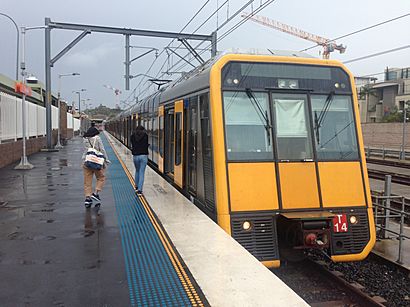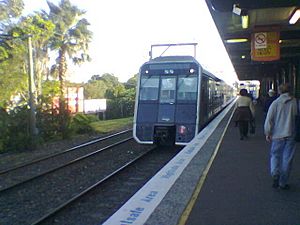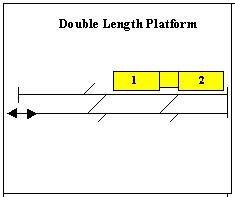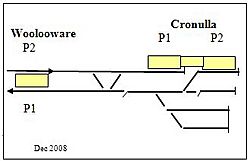Cronulla railway station facts for kids
Quick facts for kids
Cronulla
|
|||||||||||
|---|---|---|---|---|---|---|---|---|---|---|---|

T set waiting at Cronulla railway station in May 2019
|
|||||||||||
| Location | Cronulla Street, Cronulla | ||||||||||
| Coordinates | 34°03′20″S 151°09′05″E / 34.055648°S 151.151472°E | ||||||||||
| Owned by | Transport Asset Holding Entity | ||||||||||
| Operated by | Sydney Trains | ||||||||||
| Line(s) | Cronulla | ||||||||||
| Distance | 34.81 km (21.63 mi) from Central | ||||||||||
| Platforms | 2 (1 side) | ||||||||||
| Tracks | 4 | ||||||||||
| Connections | Bus | ||||||||||
| Construction | |||||||||||
| Structure type | Ground | ||||||||||
| Disabled access | Yes | ||||||||||
| Other information | |||||||||||
| Status | Staffed | ||||||||||
| Station code | CNL | ||||||||||
| Website | Transport for NSW | ||||||||||
| History | |||||||||||
| Opened | 16 December 1939 | ||||||||||
| Electrified | Yes | ||||||||||
| Traffic | |||||||||||
| Passengers (2018) | 5,370 (daily) (Sydney Trains, NSW TrainLink) | ||||||||||
| Services | |||||||||||
|
|||||||||||
| Official name | Cronulla Railway Station group | ||||||||||
| Type | State heritage (complex / group) | ||||||||||
| Designated | 2 April 1999 | ||||||||||
| Reference no. | 1123 | ||||||||||
| Type | Railway Platform/ Station | ||||||||||
| Category | Transport - Rail | ||||||||||
| Builders | NSW Department of Railways | ||||||||||
Cronulla railway station is a train station in Cronulla, Australia. It's the very last stop on the Cronulla line. The station was built in 1939 by the NSW Department of Railways. It is also known as the Cronulla Railway Station group and is listed on the New South Wales State Heritage Register because of its special history and design.
The station serves the Sydney suburb of Cronulla with Sydney Trains' T4 line services. Cronulla station is unique because its two platforms are built one after the other, not side-by-side. This makes it the second longest train platform in New South Wales, only shorter than Albury.
Contents
History of Cronulla Station
In the 1860s, a man named Thomas Holt owned most of the land from Sutherland to Cronulla. When the railway line reached Sutherland in 1885, Cronulla became a popular spot for picnics and swimming. Many people would rent beach houses there for their holidays.
In 1899, the government named the area Gunnamatta, which means "sandy hills." The local council, Sutherland Shire, was formed in 1906. In 1908, the name was officially changed to Cronulla. A steam tram line was built from Sutherland to Cronulla, opening in 1911. This made it even easier for people to visit.
The railway line from Sutherland to Cronulla was built between 1936 and 1939. This new railway line replaced the old steam tram service. It was a big project for the government during the 1930s. The Cronulla line opened on 16 December 1939.
Cronulla was a popular tourist spot, so the station was built close to the beach. Its design allowed many people to get on and off trains quickly. The station was officially opened by the NSW Governor Lord Wakehurst. The Cronulla line was also one of the first to use a special electrical signalling system. In 2010, the single track sections of the line were doubled, meaning there are now two tracks instead of one.
What Cronulla Station Looks Like
Cronulla Railway Station has several interesting parts. It faces Cronulla Street and has a very long platform. The main station building is a great example of "Inter-war Functionalist" style. This means it was designed to be practical and efficient, with clean lines and simple shapes, which was popular in the 1930s.
- Main Platform Building
This is the biggest building at the station. It has a unique design with stepped sections and curved corners. It features a clock tower facing Cronulla Street. The building has special brickwork and curved awnings that stick out over the street and the platform.
Inside, the main entrance has a cool Art Deco style ceiling with patterns that look like ocean waves. There's also an old ticket booth with timber boards that used to show train times. You can find plaques inside and outside the station that remember its opening in 1939 and its 50th anniversary in 1989.
The building has many original features inside, like old doors, window frames, and even the original equipment used to control the train signals. The waiting room still has its original seats.
- The Platform
The station has one very long platform with an asphalt surface. It's the second longest platform in New South Wales!
- Other Features
- There's a clock on the platform side of the main building.
- You can see old timber boards that used to show train information.
- There are gardens and palm trees around the station.
Platforms and Services
| Platform | Line | Stopping pattern | Notes |
| 1 |
4
|
services to & from Bondi Junction | |
|---|---|---|---|
| 2 |
4
|
services to & from Bondi Junction |
Transport Links
Several bus routes operate to and from Cronulla station:
- 969: to Sutherland station
- 971: to Hurstville
- 985: to Miranda via Woolooware Bay
- 987: to Kurnell
- 988: to Caringbah station (limited weekday service)
Cronulla station is also served by one NightRide bus route:
- N11: to City (Town Hall)
Cronulla Ferries operates one ferry route from Cronulla to Bundeena.
Trackplan
Why Cronulla Station is Special (Heritage Listing)
Cronulla Railway Station is very important to the history and design of New South Wales. It's listed on the State Heritage Register for several reasons:
- Historical Importance: It was a major government project during the 1930s, a time when many people were looking for work. It also played a big part in how the suburb of Cronulla grew.
- Design and Beauty: The station is considered one of the best examples of "Inter-war Functionalist" architecture in the NSW railway network. Its buildings have unique features like two-toned bricks, curved corners, and stepped awnings. The station looks very impressive from Cronulla Street, with its special clock tower.
- Technical Achievement: The station shows how buildings were designed and built in the mid-20th century. It also demonstrates the use of the "Inter-war Functionalist" style for a railway station.
- Rarity: Cronulla Station is a rare and outstanding example of this type of railway station design in New South Wales.
It's a great example of a railway station from that time period, both on the Cronulla line and across the entire NSW railway system.
Images for kids






